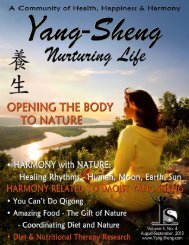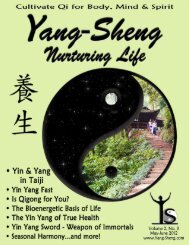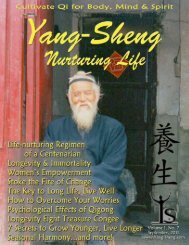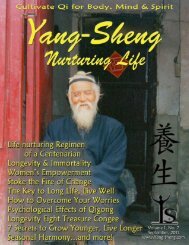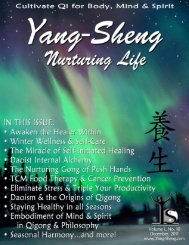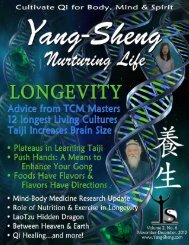Download PDF - Yang-Sheng
Download PDF - Yang-Sheng
Download PDF - Yang-Sheng
You also want an ePaper? Increase the reach of your titles
YUMPU automatically turns print PDFs into web optimized ePapers that Google loves.
Experience Exchange<br />
Listening to Your Inner Rhythms<br />
O<br />
ne of my earliest memories of really getting hooked on Tai Chi took place in a class where we were practicing<br />
the form as a big group. In one very fleeting moment, I felt three interlaced rhythms all at once: my heartbeat,<br />
the rhythm of my breath, and the cadence of the form as we all moved through it together. Each one was<br />
distinct, but layered on top of the others.<br />
It was one of those experiences where, as soon as you stop and realize you're having it, it vanishes, but the effects of that<br />
brief moment of the integrated harmony of breath, heartbeat and movement lingered. Now I had a touchstone to come<br />
back to in my practice.<br />
I didn't really understand how this experience worked. Later, I was surprised to see how harmonizing movement, breath,<br />
and intention created internal space that filled up other areas of my life too.<br />
Let me see if I can explain it. When you see people practicing the flowing movements of Tai Chi in the park, on some<br />
level you understand that the way they are moving on the outside resonates on the inside. Intuitively, you know that<br />
calming your body may lead<br />
to a calmer mind, but until I<br />
started learning Tai Chi, I<br />
couldn't get into that state in<br />
a reliable, reproduceable<br />
way.<br />
Essentially, the stillness you<br />
find inside the graceful<br />
movements of Tai Chi<br />
comes from an inward<br />
listening -- referred to in Tai<br />
Chi as "ting jin" or<br />
"listening energy". By<br />
harmonizing the rhythm of<br />
your form and the rhythm of<br />
your natural internal<br />
processes, you reach a still<br />
point.<br />
Finding the still point is<br />
different every time you<br />
practice. Think of it like<br />
going to the ocean. Are the<br />
waves smooth or angry<br />
today? Is it windy? What<br />
about the deeper currents in<br />
the water?<br />
by Dan Kleiman<br />
January, 2012 <strong>Yang</strong>-<strong>Sheng</strong> (Nurturing Life) 39




